Test Injection Can You Reuse Drawing Needle
Ready to self-inject your testosterone or hormones, but aren't sure where to start? Don't know whether self-injection is safe, or where's the best place to inject yourself? Worse, do you have a crippling fear of needles? Dry your palms and relax; we've got you and you've got this. Here, the definitive guide to all you'll need to know about injecting hormones, testosterone, including tips and tricks for self-injecting.
Before The Shot: Everything to Know and Do Ahead of a Self-Injection
Talk With Your Doctor
All doctors can show you how to give a self injection; if you need some help, email us and we'll arrange for a live tutorial. Either will be able to help you troubleshoot issues or point out common errors and, with telehealth on the rise, a video chat with a medical professional to observe your first shot is increasingly common. That can help ease your mind through the ginormous mental jitters surrounding your first shot. (And it truly gets easier after the first shot. Nearly all my patients finish the first self-injection saying, "That's it?! That was nothing.")
Ready Your Mind and Equipment
Clearing up common self-injection questions and myths
Let's run through a few common questions you may be having to help dispel some common misconceptions about self-injections.
First, is self-injection safe? Self-injection, done properly — meaning with a prescribed substance, under the direction of a physician — is completely safe. Blackmarket needles, self-sourced substances, and using your own needles; these are things that make self-injection unsafe. As long as your course of treatment is guided by a physician, you're good.
Is it hard to inject yourself? It's not difficult. The initial shot will be the hardest, but the rest will be smooth sailing. The biggest fear here is the pain associated with the needle and a phobia of needles themselves. When I've got a patient struggling with self-injections, I advise them to:
-
Numb the injection site. You can do this by placing ice there for one or two minutes prior to injection. Or you can use an over-the-counter numbing agent, like Aspercreme with lidocaine. If you don't feel the pierce of the needle, that helps significantly.
-
Focus on breathing. It's common to start hyperventilating because of anxiety. Concentrate on taking measured, deep breaths to stay calm.
-
Stretch the skin at the injection site. Right before you position the needle, spread the skin as tightly as you can with your thumb and forefinger. It helps distract your brain by refocusing it on the tactile sensation, but it also enables the needle to go in easier.
-
Try a tool like Buzzy. Buzzy is what we use in the emergency room for anyone with a phobia of needles. It's a device that has an attached freezer pack and a vibration motor and you position it right above the injection site. Your body feels both the coldness and a vibration; the cool sensation helps block pain while the vibration occupies the brain so it can't focus on the fear of the shot.
-
Try an autoinjector. You load the syringe and just position it and hit a button. The autoinjector will shoot the needle in and you push the plunger. These can help a lot.
-
Look away at the last second. If you position the needle and turn your head away as you push it in then push the plunger, that can help. Many people don't like to watch the needle go into their skin.
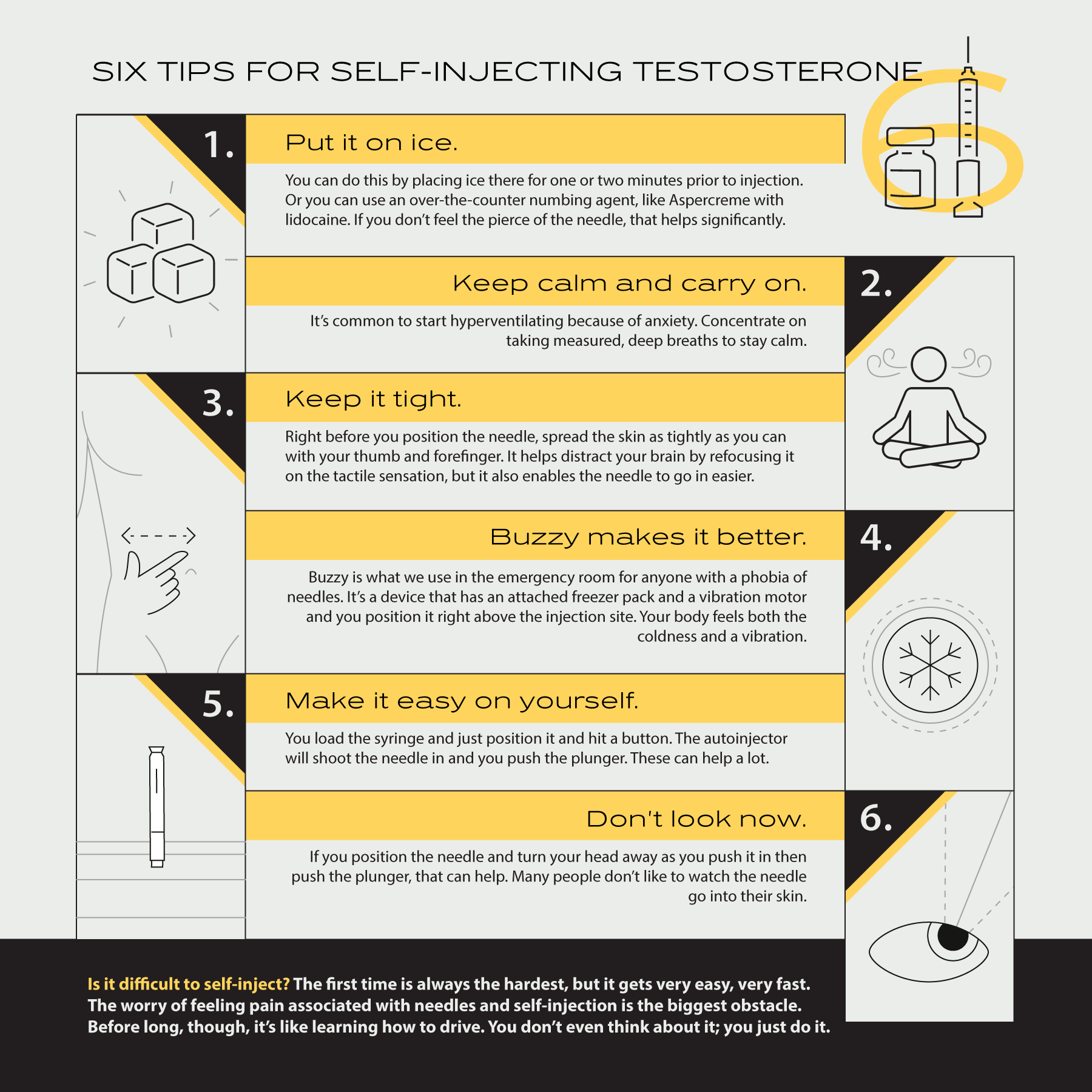
How do you get over a fear of injecting yourself? It's really about getting through the first shot. Before any patient who needs to self-inject tries on his or her own, we do a test run together with me in the room. That helps them see how easy this is and that they can definitely do it on their own.
New needles, only.
Never, ever reuse needles. Reusing needles is problematic because they are unsanitary but also because after the first use, the needle is blunted immediately, meaning the next time you use it will be more painful. Always keep a fresh supply of new needles in your home and use one for each injection.
A needle is one part of a syringe. Let's quickly talk about the other parts. The tip is the area of the syringe where the needle attaches. The barrel is the tube area that's open at one and narrows into the hollow tip at the other end. There are lines on the barrel to help you see the volume of solution within it. The plunger is the rod that sits within the barrel and operates like a piston; you can pull or push it to help get solutions into and out of the barrel.
You can connect multiple needles to a syringe, depending on the action required. Needle diameter is measured by gauge numbers, which indicates the bore of a needle's lumen (a fancy word for the hole at the tip of the needle). The higher the gauge number, the smaller or thinner the hole; the lower the gauge number, the bigger or thicker the hole. Higher gauge needles can reduce pain when injecting, but larger needles are required for injecting larger volumes of oil-based substances (like testosterone) into the muscle.
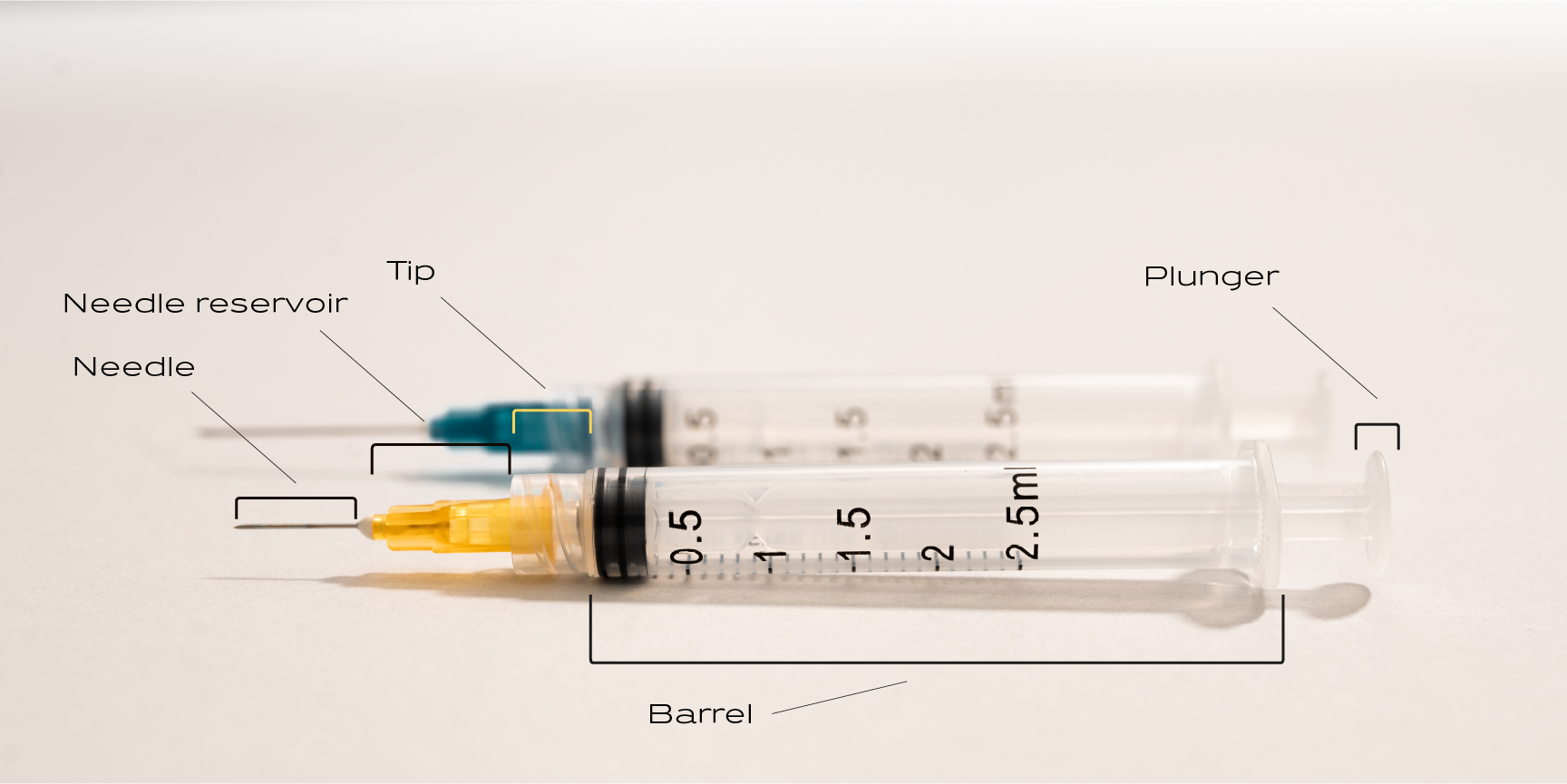
The last thing you'll need to know about needles is the length of the needle itself. This number is listed after the gauge number. For example, a 25G ½ indicates that this is a 25 gauge needle that is a half-inch long.
The location of the injection will help you determine the needle size, but your weight could play a factor too; slightly larger individuals may require a slightly larger needle as there is more tissue for the needle to penetrate.
At Hone, we recommend three sizes of needles, one for injections that are under the skin — subcutaneous (or SubQ) — and two for injections that are going into the muscle — intramuscular (or IM). More on those two types of injections in a second, but the subcutaneous needle is a 27-30 gauge and either a half-inch to ⅝ of an inch long. For intramuscular injections, we send two needles: a 20 gauge to use to draw in the medicine, and a 23 gauge for the injection itself (some individuals may use this for a subcutaneous injection, after a little experience). Intramuscular needles are longer, between one to one and a half inches, because it needs to penetrate into the muscle.
The rest of the gear
It's important to have everything prepped and ready before you start your self-injection. You don't want to be mid-shot and realize you need something handy. You'll want to have the following things within arm's reach.
-
Your testosterone or medicine vial
-
Needles and syringes
-
Alcohol swabs. You'll want to sterilize and disinfect the rubber top of the medication vial and your injection site
-
Gauze or a cotton ball, for applying gentle pressure to the injection site immediately afterward for a few seconds
-
Band-Aids, in case there's any blood (this is more common in intramuscular injections)
-
A sharps container. This is a puncture-proof container for safe needle disposal
-
Soap, so you can wash your hands thoroughly
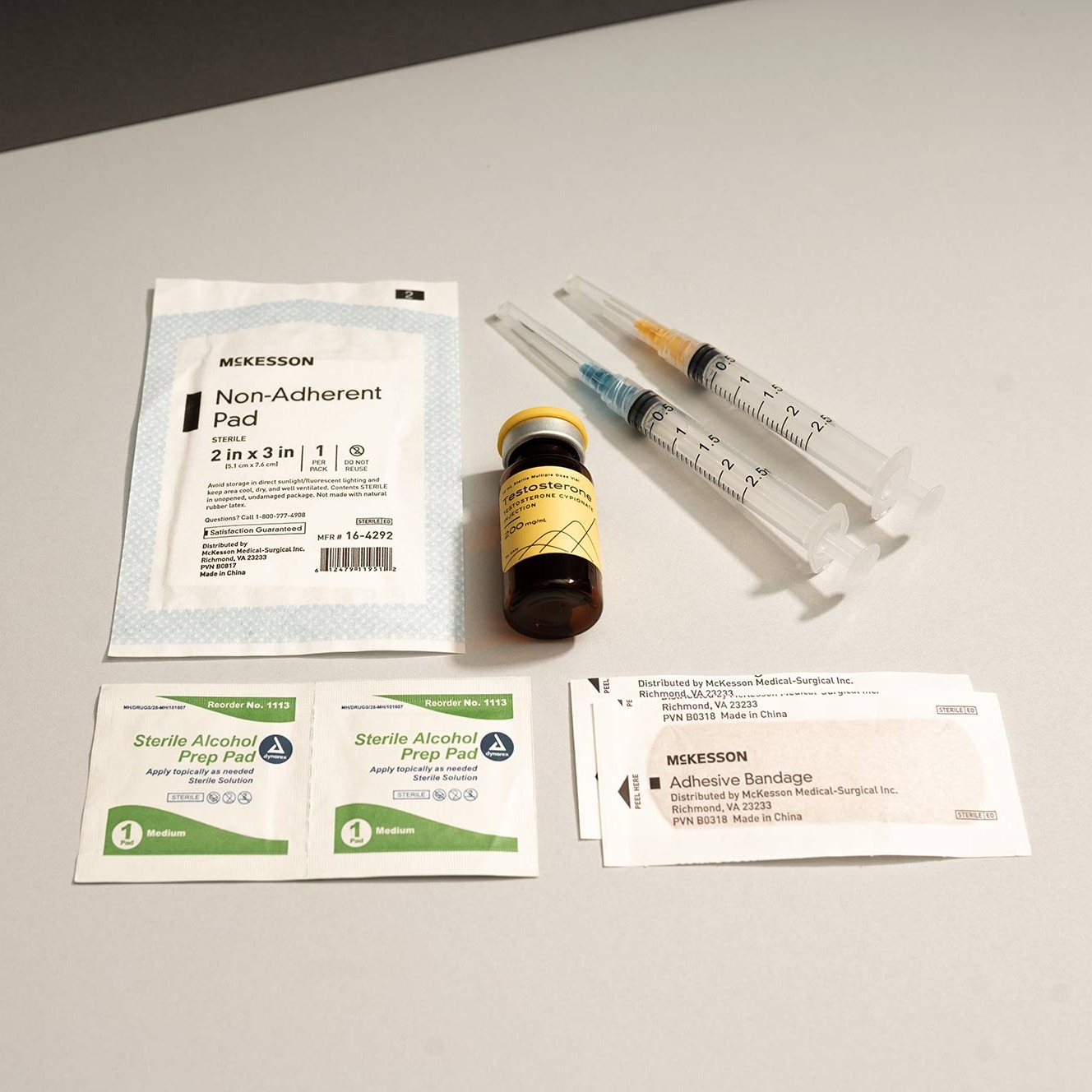
Prep everything
First, you'll want to wash your hands with soap for at least 20 seconds. Next, you'll clean the top of your medication vial with an alcohol swab and let it dry completely (you don't want to push any residual alcohol into the testosterone or medicine). Next you'll want to scrub your injection site with a fresh alcohol swab, letting that dry completely as well. Lastly, if you need an injection aid, like the Buzzy or ice or a numbing agent, you should have those ready.
What Are You Injecting?
If you're doing testosterone replacement therapy (TRT), you're injecting testosterone. Again, provided you're working under the guidance of a medical professional, injecting testosterone is perfectly safe. There are several ways to introduce testosterone to your body, but the benefits of injecting testosterone is that injections are highly effective and the dosage is consistent,[1] studies have shown. Testosterone in the bloodstream is quickly eliminated, so injections slowly release the hormone into the bloodstream over a longer period of time.
You could take testosterone orally, in a 75 mg tablet, but that first has to pass through the liver before it can hit the vasculature and be introduced into your bloodstream. The liver metabolizes so much of the testosterone that it's hard to get your levels up significantly. There's also a troche, which is a candy that goes under your tongue and gets absorbed into your bloodstream, bypassing the liver. There are testosterone creams, too, but the absorption rate in the cream is difficult. Plus, these require daily use and when the cream gets on your hands, even if you wash them, you can transfer it to an object or another person, which can be a problem.
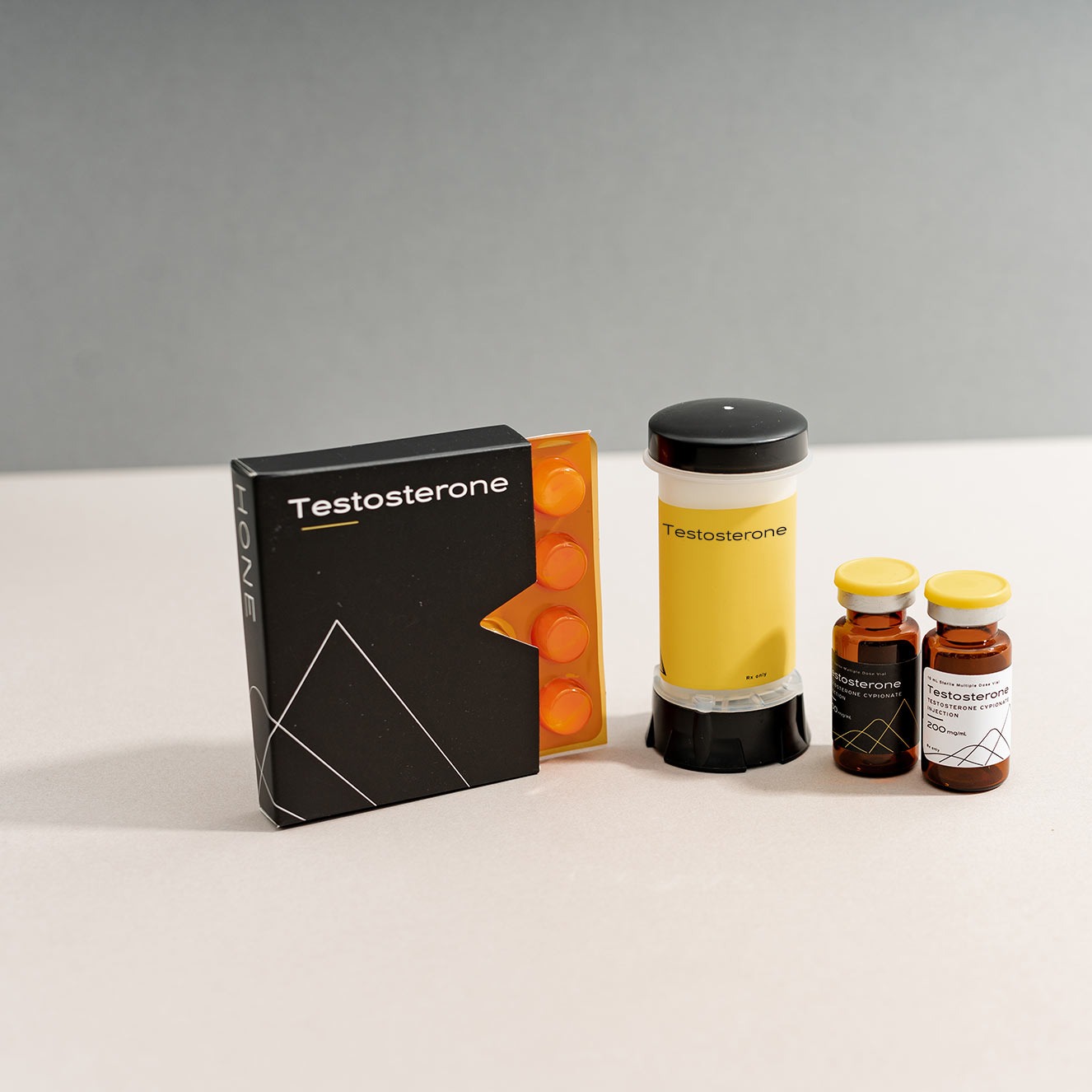
The frequency required to administer cream and tablet versions of testosterone can also lead to compliance issues, meaning it's easier to forget to do it on any given day. I'm lucky if my patients using a cream remember to do it five days a week. Because you're only self-injecting one or two times a week, you're more likely to hit all your prescribed doses. That coupled with the efficacy — studies also show more muscle strengthening in injections[2] — point to injections of testosterone being the best method for testosterone replacement therapy.
Common Testosterone Injection Questions
What's the best time of day to inject testosterone? Traditionally, it's the morning. It's not scientifically necessary to inject testosterone in the morning, though our testosterone is at the highest levels in the morning. The reason for the morning push is more about creating a routine to ensure you're not missing doses. However, there's no difference in the time of day you're injecting; I've not seen a study that indicates there's any change in efficacy between the morning and the afternoon or the evening. Whatever time you select, keep to that time. Consistency is key to building a routine.
Is it better to inject testosterone once or twice a week? The answer here varies, depending on your doctor's preference but also your dosage. Typically, once or twice per week is the norm. Some guys don't want to self-inject twice per week, so they want to get the whole week's dose delivered at once. If your treatment course calls for, say, a 200 mg dose, with one shot of all 200 mg, your testosterone levels would peak about four days after, then drop off. If you injected 100 mg on at the beginning of the week and another 100 mg towards the end of the week, your peak isn't as high and your low isn't as low. Twice per week is preferred for the balance of testosterone delivery.
What's the best place to inject testosterone? This is really about personal preference; where it's the least painful and easiest for you to inject. If you have help in the form of a loved one or friend, you can do an intramuscular injection in the upper outer glute or the deltoid. If you're self-injecting, you can do a subcutaneous injection and use the abdomen or the upper outer thigh (never the inner thigh; there are too many veins you have the potential of hitting).

What is the optimal testosterone injection dosage? The answer here varies based on your individual plan. Your doctor's goal is to get your testosterone level as high as possible, within the right range, without seeing any negative side effects. Because everyone's body is different, you will metabolize testosterone differently than someone else. I've seen some guys require 400 mg per week while others only need 100 mg for the same results. Listen to your clinician's advice and don't increase your own dosage.
How long before testosterone injections work? It's important to define "work" here. The goal of testosterone replacement therapy differs; maybe you're trying to combat fatigue or increase your endurance or libido; others may be trying to correct other issues. The quality of life benefits typically arrive within three or four weeks after the start of treatment. You should start to notice that you'll have more energy and vitality around that time. Brain fog should start to clear up, and your motivation and drive should improve. Hot flashes should abate, and your sleeping should improve. With TRT, some things can take longer before you notice effects, however. If you're grumpy, sad, moody, or depressed, or experiencing weight gain or a loss of muscle; it can take three or four months before you notice a change in those areas.
What are side effects of testosterone injections? Many times, side effects occur when there's an imbalance. When the doses are wrong, or supraphysiologic — very strong — doses. (Side effects also are far more common in self-procured testosterone.) Testosterone injection side effects include increased body hair, a loss of hair on your head, breast enlargement, oily skin, acne (commonly, on the back of head, on the shoulders, or on the chest), a deeper voice because vocal chords thicken, and fatigue. The testosterone stimulates the kidneys to produce a hormone within the kidney, so your red blood cell count increases, causing fatigue. Other side effects include a decrease in sperm and trauma or bruising at the injection site.
If your dose is supraphysiologic (between 1100 and 1500 mg), you may experience mood swings, high blood pressure, headaches, and an enlarged prostate. If your dose is in the 800 - 1000 mg range, you usually don't have any of these issues.
Why Testosterone Can Be Tricker to Inject
Testosterone can be tougher to inject than, say, insulin, because the hormone is held within an oil, either sesame or grapeseed. Because it's thicker, you may need two needles: a low gauge for the vial of medicine and a higher gauge for your body. If you use a high gauge needle to extract the testosterone from the vial, it's going to be a laborious process to get the medicine through that smaller bore.
How to Choose an Injection Type: Intramuscular or Subcutaneous
I'm often asked what's the best way to inject testosterone: intramuscular or subcutaneous? Both are equally effective and you can choose whichever you prefer or find less painful. Old school doctors may disagree, but several studies have shown that subcutaneous testosterone injections have as much efficacy as intramuscular — long believed to be the superior method. Still, there are advantages and disadvantages to IM and SubQ. Let's spin through those.
Subcutaneous shots — shots that go right under the skin — are far easier to self-administer. SubQ shots go directly into fatty tissue beneath the dermal and epidermal layers of the skin; generally into the subcutaneous tissue of the abdomen or outer upper thigh. The absorption of your testosterone is slower as there are fewer blood vessels in the fatty tissue; this is actually an advantage, however, if you're looking for a prolonged effect. SubQ shots are less painful since you're using smaller gauge needles and injecting into fatty tissue beneath the skin versus into your muscle. Accordingly, there's no risk of damaging muscle since you're injecting into fatty tissue. There's also no risk of accidentally hitting your sciatic nerve. At Hone, many of our staff are clients as well and most prefer the subcutaneous route.
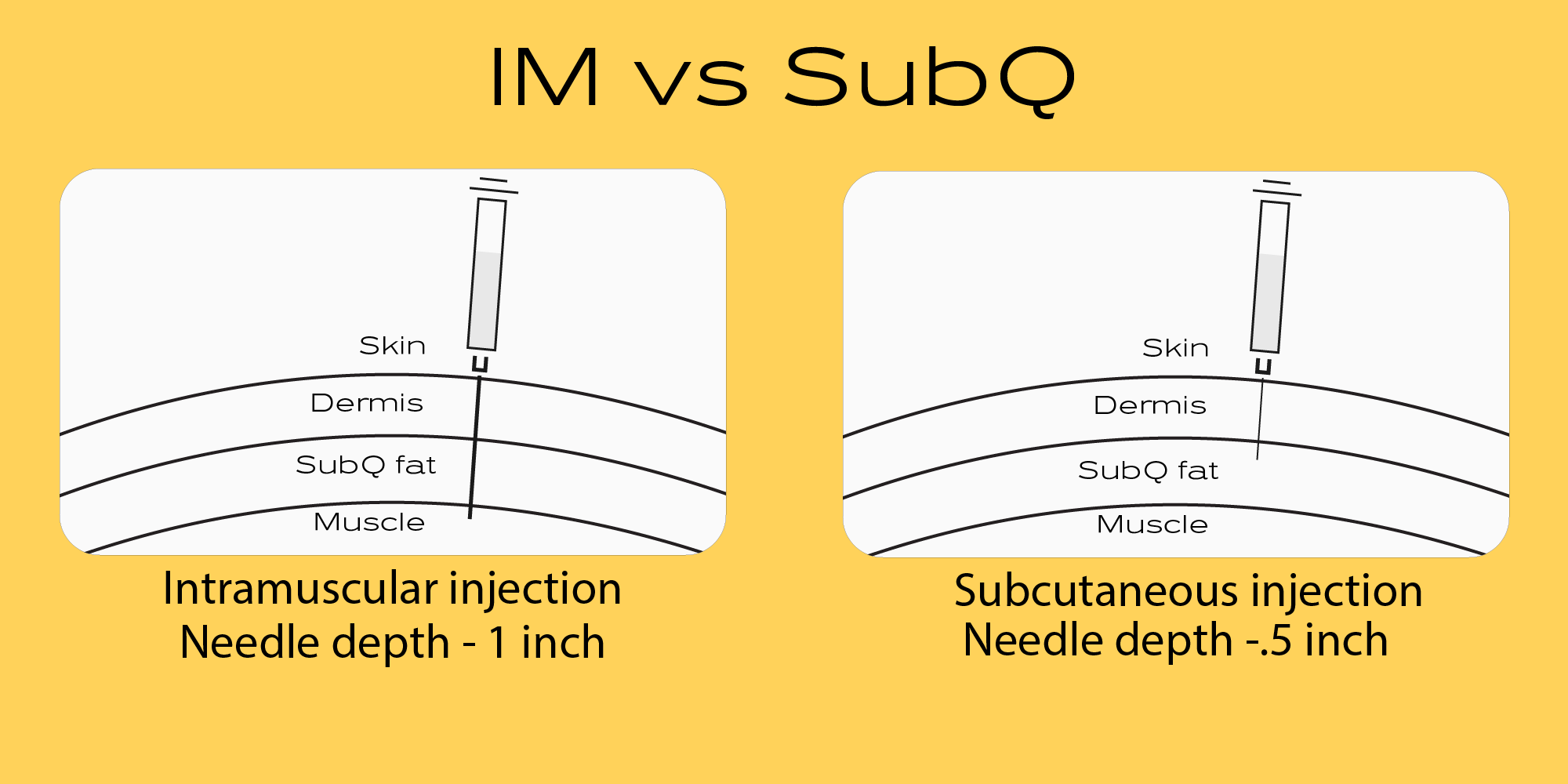
On the flip side, with SubQ injections, irritating solutions or more concentrated dosage might cause sloughing off of the skin epithelial tissue. There is less blood flow to quickly absorb the injection of testosterone. SubQ injections of more than 1 mL of testosterone at a time is often discouraged; larger amounts run a higher risk of not being absorbed properly or causing discomfort. Lastly, SubQ injection sites are more susceptible to infection of the injected area than via IM, as the area is less vascularized.
Intramuscular shots — needles that go deep into the muscle tissue — were believed to be superior because the medication can be absorbed into the bloodstream more quickly, due to muscle fibers having a greater blood supply than the tissue under your skin. As mentioned earlier, SubQ shots are equally as effective as IM shots, but among the reasons to opt for IM is that you can deliver a larger volume of testosterone than with a SubQ shot. There's also a lower incidence of immediate injection site reactions and also minimal irritation caused by the medication.
The downsides of IM shots include that absorption of the testosterone is determined by the bulk of your muscle and its vascularity. The onset and duration of the drug is not adjustable. IM injections can be slightly more painful overall than SubQ, with more bruising. You run the risk of accidentally hitting important nerves, including your sciatic nerve. Suspensions or oily drugs cannot be administered with IM injections.
Choosing an Injection Site
For intramuscular injections, you'll want to inject into your gluteal muscle (your butt), your thigh muscle, or your shoulder muscle. With subcutaneous injections, you'll want to inject into your stomach area or your shoulder.
Your ultimate goal, regardless whether you're going with IM or SubQ, is to avoid any arteries or veins with the needle. With IM injections, that means always choosing a spot within the upper outer thigh — your inner thigh is too vascular. As to where to inject within the glute, the answer is the same: the upper outer portion of your glute.
With either IM or SubQ, rotating injection sites helps. With any injection, there's trauma to the tissue so if you go back into the same area, that pain will increase. If you're doing IM injections in your thigh, do the right thigh first, then the left thigh. Rotated between your left and right glute. If you're doing SubQ injections into your abdomen, draw an imaginary square around your belly button and rotate injections at the corners of that square.
How to Actually Self-Inject
Ready to administer? Take a deep breath and remember that you can do this.
1 - Wash your hands thoroughly with warm water and soap, scrubbing for at least 20 seconds.
2 - Make sure the vial of medicine is at room temperature. Many guys store their TRT doses in the fridge; don't do that. It's not medically necessary and the cold testosterone will feel very uncomfortable when it goes into your body. If you've kept your TRT dose in the fridge and do need to warm it up, you can either run it under warm water, hold it in your fist for several minutes, or even stick it in your armpit.
3 - Clean the top of the medicine vial with an alcohol swab and wait for it to completely dry. Residual alcohol that gets onto the needle and is still wet will sting you more when injecting.
4 - Attach whichever needle you're using to the syringe. You'll want to draw the plunger back and fill the syringe with air, the same amount of air as the amount of medication you're planning to inject.
An aside about understanding your dose. You'll receive your testosterone in the mail and you'll need to read what the physician is prescribing to know how much to inject but also how often: once or twice per week. It'll say something like 100 mg or ½ mL once per week. Mg — or milligrams — is typically the amount of the testosterone you have, while mL — or milliliters — is the amount of the solution that the testosterone is in. If there's any confusion surrounding your prescription and doses, please call and ask us.
5 - With your TRT vial on an even surface, insert the needle into the now-dry rubber top and push the plunger down, forcing all the air into the vial. This is called aspirating the bottle. It will help you get the medication out of the vial more easily.
6 - Pick up the vial with the needle inside it and turn it upside down. Ensure that the tip of the needle is fully covered by the liquid within the vial. Steadily pull the plunger out, drawing the medicine into the syringe. Make sure you're not drawing in air bubbles, which can throw off the measuring of your dose. Pull the plunger back until it matches the line of your prescribed dose.
Remember, because testosterone is thicker, if you're using a SubQ injection needle, it will take a longer time. While it can take anywhere from five to 30 seconds with an IM needle, you'll need to be very patient with a SubQ needle; it can take up to a minute to get the dose into the syringe. That time is the price you pay for not having any pain.
Once the dose is within the barrel of the syringe, slightly pull the plunger back further to draw any further medication out of the needle, so you're not losing any.
7 - Remove the needle from the vial and swap needles, if you need to. Take care to always cap any needles and immediately place them into your sharps container.
8 - Hold the syringe upright and tap the barrel to move any air bubbles to the top of the syringe. Carefully depress the plunger to remove excess air from the syringe and into the tip of your injection needle. When you get a tiny drop from the tip, that indicates that the air has been fully removed and you're ready to complete your injection.
9 - Clean the skin at your injection site with a fresh alcohol swab. Again, let it dry completely because alcohol can irritate your skin when it's pierced.
10 - Hold the needle at a 90-degree angle to your body. Never inject yourself at any other angle than 90 degrees because you're not fully penetrating in the way you need to. When you're ready, insert the needle into your skin.
Wondering how far to inject the needle? If you're doing SubQ injections, your needle should only be a half inch long, so insert it all the way to the hub. If you're doing an IM injection, you'll want to go an inch and a half deep.
11 - Just before you inject the medicine, pull back on the plunger just a little. If you see blood enter the syringe, you've tapped a vein. Remove the needle and try again at a different injection site. If you do not see blood, then you're good to inject.
12 - Push the plunger down to inject the medicine.
13 - Remove the needle at the same angle it was inserted.
After the Shot
All done? Congrats. What now?
Needle Disposal
First, cap your needle and throw it in your sharps container. You can get a sharps container in most pharmacies, but if you can't locate one, an empty laundry detergent bottle can also work. When your sharps container is filled, you can return it to the pharmacy for proper disposal. Check your local rules to see if your state allows you to place a filled sharps container in with your trash.
Never throw needles into the garbage.How to take care of injection site post-injection
If you'd like, you can ice the injection site, to help reduce swelling, inflammation, and redness. If you're experiencing redness, swelling, bruising, or a little bleeding, that's not uncommon. Place a cotton ball on the injection site to help stem any bleeding, and you can place a Band-Aid over it after. Remember to rotate your injection sites for your next shot.
References:
[1] Pastuszak AW, Gomez LP, Scovell JM, Khera M, Lamb DJ, Lipshultz LI. Comparison of the Effects of Testosterone Gels, Injections, and Pellets on Serum Hormones, Erythrocytosis, Lipids, and Prostate-Specific Antigen. Sex Med. 2015 Sep;3(3):165-73. doi: 10.1002/sm2.76. Epub 2015 Aug 12. PMID: 26468380; PMCID: PMC4599554.
[2] Ottenbacher KJ, Ottenbacher ME, Ottenbacher AJ, Acha AA, Ostir GV. Androgen treatment and muscle strength in elderly men: A meta-analysis. J Am Geriatr Soc. 2006 Nov;54(11):1666-73. doi: 10.1111/j.1532-5415.2006.00938.x. PMID: 17087692; PMCID: PMC1752197.
HRT
Self-Injection
Men's Health
Hormones
TRT
Testosterone

Test Injection Can You Reuse Drawing Needle
Source: https://www.honehealth.com/the-edge/self-injection-testosterone-hormone-instructions
0 Response to "Test Injection Can You Reuse Drawing Needle"
Post a Comment